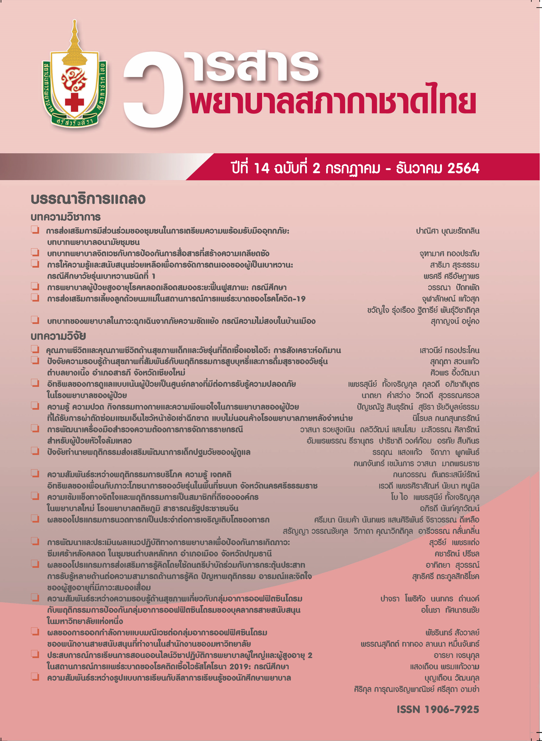Role of Psychiatric Nurses in Hate Speech Prevention
Keywords:
role of psychiatric nurses, prevention, hate speech, mental healthAbstract
Technology and internet play an ever-greater role in facilitating life communication with others. Nowhere is this more evident than in social media, as it can enable people to communicate and receive information more quickly. It has also facilitated the presence of hate speech, which has seriously impacted victims, particularly those with mental health issues such as those dealing with fear, anxiety, low self-esteem, and depression. Severe symptoms can lead to self-induced harm. Therefore, when a person is confronted with a hate speech, they should be familiar with a way to manage or cope with the situation. This article aims to examine hate speech, looking not only at the meanings and compositions, but also the objectives and patterns of the perpetrators, their identity base, and the severity and impact of the mental health problems and the role of psychiatric nurses in preventing these problems arising from hate speech.
References
United Nations. United nations strategy and plan of action on hate speech [Internet]. 2019 [cited 2021 Mar 10]. Available from: https://www.un.org/en/genocideprevention/hate-speech-strategy.shtml
Saha K, Chandrasekharan E, De Choudhury M. Prevalence and psychological effects of hateful speech in online college communities. Proc ACM Web Sci Conf [Internet]. 2019 [cited 2021 Mar 10];255-64. Available from: https://www.ncbi.nlm.nih.gov/pmc/articles/PMC7500692/
Suksanguan N. Media revolution for supporting hate speech. The Secretariat of The Senate 2014;4(14):1-32. (in Thai)
Inthanon S, Wirunrapan K, Konglarp L, editors. Hate speech. Bangkok: Natchawat printing; 2018. (in Thai)
Phanichsiri K, Tuntasood B. Social media addiction and attention deficit and hyperactivity symptoms in high school students in Bangkok. J Psychiatr Assoc Thailand 2016;61(3):191-204. (in Thai)
Ramasoota P. Supervision of internet content. Bangkok: Chulalongkorn University Printing; 2013.
Pattaratamrong P. Exposure and attitudes toword social media hate speech on the stopfakethailand facebook page [Thesis]. Bangkok: Thammasat University; 2016. (in Thai)
De Choudhury M, Kiciman E, Dredze M, Coppersmith G, Kumar M. Discovering shifts to suicidal ideation from mental health content in social media. Proc SIGCHI Conf Hum Factor Comput Syst [Internet]. 2016 [cited 2021 Mar 10];2098-110. Available from: https://www.ncbi.nlm.nih.gov/pmc/articles/PMC5659860/
Alhajji M, Bass S, Dai T. Cyberbullying, mental health, and violence in adolescents and associations with sex and race: data from the 2015 youth risk behavior survey. Glob Pediatr Health [Internet]. 2019 [cited 2021 Mar 10];6:2333794X19868887. Available from:
https://www.ncbi.nlm.nih.gov/pmc/articles/PMC6686314/
Hellfeldt K, López-Romero L, Andershed H. Cyberbullying and Psychological well-being in young adolescence: the potential protective mediation effects of social support from family, friends, and teachers. Int J Environ Res Public Health [Internet]. 2019 [cited 2021 Mar 10];17(1):45. Available from: https://pubmed.ncbi.nlm.nih.gov/31861641/
Kaiser S, Kyrrestad H, Fossum S. Cyberbullying status and mental health in Norwegian adolescents. Scand J Psychol [Internet]. 2020 [cited 2021 Mar 10];61(5):707-13. Available from: https://onlinelibrary.wiley.com/doi/full/10.1111/sjop.12656
Hébert M, Cénat JM, Blais M, Lavoie F, Guerrier M. Child sexual abuse, bullying, cyberbullying, and mental health problems among high schools students: a moderated mediated model. Depress Anxiety [Internet]. 2016 [cited 2021 Mar 11];33(7):623-9. Available from: https://pubmed.ncbi.nlm.nih.gov/27037519/
Niu G, He J, Lin S, Sun X, Longobardi C. Cyberbullying victimization and adolescent depression: the mediating role of psychological security and the moderating role of growth mindset. Int J Environ Res Public Health [Internet]. 2020 [cited 2021 Mar 11];17(12):4638. Available from: https://www.ncbi.nlm.nih.gov/pmc/articles/PMC7345096/
Martínez-Monteagudo MC, Delgado B, Díaz-Herrero Á, García-Fernández JM. Relationship between suicidal thinking, anxiety, depression and stress in university students who are victims of cyberbullying. Psychiatry Res [Internet]. 2020 [cited 2021 Mar 11];286:112856. Available from: https://www.sciencedirect.com/science/article/abs/pii/S0165178119323194
John A, Glendenning A, Marchant A, Montgomery P, Stewart A, Wood S, et al. Self-Harm, suicidal behaviours, and cyberbullying in children and young people: systematic review. J Med Internet Res [Internet]. 2018 [cited 2021 Mar 11];20(4):e129. Available from: https://pubmed.ncbi.nlm.nih.gov/29674305/
Cassidy W, Faucher C, Jackson M. Cyberbullying among youth: a comprehensive review of current international research and its implications and applicationto policy and practice. Sch Psychol [Internet]. 2013 [cited 2021 Mar 11];34:575-612. Available from:
https://journals.sagepub.com/doi/10.1177/0143034313479697
Del Rey R, Ortega-Ruiz R, Casas JA. Asegúrate: an intervention program against cyberbullying based on teachers’ commitment and on design of its instructional materials. Int J Environ Res Public Health [Internet]. 2019 [cited 2021 Mar 11];16(3):434. Available from: https://www.ncbi.nlm.nih.gov/pmc/articles/PMC6388148/
Notar CE, Padgett S, Roden J. Cyberbullying: resources for intervention and prevention. Univers J Educ Res [Internet]. 2013 [cited 2021 Mar 12];1(3):133-45. Available from: https://files.eric.ed.gov/fulltext/EJ1053892.pdf
Silva MAI, Monteiro EMLM, Braga IF, Ferriani MdGBdC, Pereira B, Oliveira WAd. Antibullying interventions developed by nurses: Integrative review. Enfermería Global [Internet]. 2017 [cited 2021 Aug 10]:563-76 Available from:
https://scielo.isciii.es/pdf/eg/v16n48/en_1695-6141-eg-16-48-00532.pdf
Espelage DL, Hong JS. Cyberbullying prevention and intervention efforts: Current knowledge and future directions. Can J Psychiatry [Internet]. 2017 [cited 2021 Mar 12];62(6):374-80. Available from: https://journals.sagepub.com/doi/10.1177/0706743716684793
Downloads
Published
Issue
Section
License

This work is licensed under a Creative Commons Attribution-NonCommercial-NoDerivatives 4.0 International License.
เนื้อหาบทความหรือข้อคิดเห็นต่างๆ ในวารสารพยาบาลสภากาชาดไทยนี้ เป็นความคิดเห็นของผู้เขียนบทความ ไม่ใช่ความเห็นของกองบรรณาธิการ หรือสถาบันการพยาบาลศรีสวรินทิรา สภากาชาดไทย






